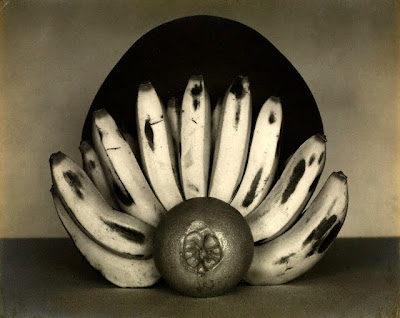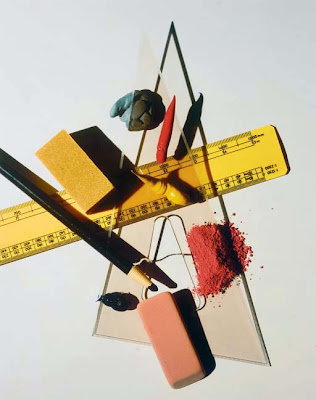Hi there, Photogs!
As we start our amended fourth quarter, we're going to restart the Still Life unit, but do it properly.
I would like you to peruse the images below, and read the written components within the post. There's some history, and then some photographic work. Mostly, it's intended to give you a glimpse of the still life as an art form.
We're starting slow with looking and reading, and will get to image making in the next post.
:) H
DIRECTIONS:
1. Look at the photos below.
2. Read the passages & click the links that are sprinkled throughout the post.
3. Read the article in the final images (they're pages from a magazine about photographic still life)
4. From around your house, gather objects of all sorts that will make for interesting subject matter for Still Life, Part 1 (the next post)
**NOTE: This first post is to simply get you thinking. 🤔
STILL LIFE PAINTING (Some history).
 |
| Ambrosius Bosschaert (1573-1621), Still-Life of Flowers, (1614) |
 |
| Harmen Steenwyck (1612-1656). Still Life: An Allegory of the Vanities of Human Life. (oil on oak panel, 1640) |
 |
| Jean Baptiste Siméon Chardin. The Brioche. (oil on canvas, 1763) |
| The Magic of Things: Still Life Painting 1500-1800 Opens at Kunstmuseum Basel |
Dewdrops on dainty petals, light glancing off precious silverware, candied confectionery in blue and white Chinese porcelain bowls, the soft plumage of a dead songbird, the pale hue of a skull – still lives have not ceased to exercise their spell upon us to this day with their close-up views of inanimate, yet by no means lifeless objects reproduced with painterly finesse. However, still life painting was anything but a merely aesthetic affair, even if today’s viewer tends to perceive it as such. It reflects not only a feeling of transitoriness and a longing for redemption, but also the pleasure of visually representing exotic trading goods with which Dutch and other merchants made their fortunes.
Since its emancipation from the religious painting of the late Middle Ages, when objects mainly served as symbols or attributes, still lives initially provided a means of understanding and interpreting things from the viewer’s everyday world that were lying still. These objects reflected the order and structure of the Baroque era’s superior abstract world: the human senses or a certain temperament, the elements or the seasons informing the individual’s world, or transitoriness and guilty mankind’s need of redemption.
The artists experimented with various kinds of lighting from the even brightness of daylight to the weak glow of a single candle, utilizing them for the mise-en-scène of manifold situations and moods.
 |
| Margareta Haverman (Dutch, active by 1715, died in or after 1723). A Vase of Flowers, 1716. Oil on wood |
Several female artists of the Netherlands specialized in flower pictures, the best known being Rachel Ruysch (1664–1750). Despite his secretive nature, Jan van Huysum accepted Haverman as his pupil in Amsterdam. She moved to Paris (about 1720?), married an architect, and in 1722 became a member of the Académie Royale. A year later, she was expelled because her reception piece was claimed to be by van Huysum himself. The only other known work by Haverman is a signed but undated flower piece in Copenhagen.
 |
| Luis Egidio Meléndez (or Menéndez) (Spanish, 1716–1780). The Afternoon Meal (La Merienda), ca. 1771. Oil on canvas |
 |
| Vincent Van Gogh. Still Life: Vase with Roses. Oil on canvas. Saint-Rémy: May, 1890 |
 |
| Juan Gris (1887-1927). Still Life with Open Window, Rue Ravignan. (oil on canvas, 1915) |
 |
| Henri Matisse. The Goldfish. (oil on canvas, 1912) |
 |
| Giorgio Morandi (1890-1964). Still Life with Cups and Boxes. (oil on canvas, 1951) |
 |
| Zao Wou-Ki. 1951 |
 |
| Andy Warhol. ca. 1960's |
 |
| Roy Lichtenstein. Still Life with Glass and Peeled Lemon. 1972 |
Artists to investigate (Copy these names in to a Google Search and get inspired!):
Willem van Aelst, Pieter Aertsen, Abraham van Beyeren, Peter Binoit, Jan Brueghel d. Ä., Jan Brueghel d. J., Jean Siméon Chardin, Adriaen Coorte, Georg Flegel, Jan Fyt, Willem Claesz. Heda, Jan Davidsz. de Heem, Cornelis de Heem, David Cornelisz. de Heem, Hans Holbein d. J., Justus Juncker, Willem Kalf, Jan van Kessel, Simon Luttichuys, Jacob Marrel, Abraham Mignon, Pieter de Ring, Ludger tom Ring d. J., Rachel Ruysch, Isaak Soreau, Peter Soreau, Harmen Steenwijck, Sebastian Stoskopff, Jan van de Velde, Jacob van Walscapelle, Gottfried von Wedig, and Jan Weenix.
THE PHOTOGRAPHIC STILL LIFE
Still life photography has served as both a conventional and an experimental form during periods of significant aesthetic and technological change.
With its roots in antiquity, the term “still life” is derived from the Dutch word stilleven, coined during the 17th century, when painted examples enjoyed immense popularity throughout Europe. The impetus for a new term came as artists created compositions of increasing complexity, bringing together a greater variety of objects to communicate allegorical meanings.
Still life featured prominently in the early experiments of the pioneers of the photographic medium and, more than 190+ years later, it continues to be a significant motif for contemporary photographers.
 |
| Armand-Pierre Séguier (French, 1803 – 1876). ‘Still Life with Plaster Casts’. 1839 – 1842. Daguerreotype 8 x 6 in. |
 |
| Charles Aubry (French, 1811 – 1877). [An Arrangement of Tobacco Leaves and Grass]. about 1864. Albumen silver print |
 |
| Paul Strand (American, 1890 – 1976). [Black Bottle]. negative about 1919; print 1923 – 1939. Gelatin silver, on Cykora paper print |
 |
| Albert Renger Patzsch. Flatirons for Shoe Manufacture. 1926./ Glasses. 1927. Gelatin silver print |
Renger-Patzsch achieved in his renderings of objects and the material world. As a protagonist of the movement that came to be known as Neue Sachlichkeit (New Objectivity), he wanted to record, phenomenologically as it were, the exact appearance of objects—their form, material, and surface. Thus he rejected any kind of artistic claim for himself. Believing that the photographer should strive to capture the "essence of the object," he called for documentation rather than art.
 |
| Edward Weston (American, 1886 – 1958). ‘Bananas and Orange’. April 1927. Gelatin silver print |
 |
| André Kertész (American, born Hungary, 1894 – 1985). [Bowl with Sugar Cubes]. 1928. Gelatin silver print |
For Bowl with Sugar Cubes, photographer André Kertész created a still life out of a simple bowl, spoon, and sugar cubes, demonstrating the photographer’s interest in the compositional possibilities of layering basic geometric forms on top of one another – three rectangles in a circle (sugar cubes and bowl) and a circle in a square (bowl and the cropped printing paper). A visual sophistication is achieved through his adroit (definition) use of simple objects and dramatic lighting.
 |
| Edward Weston. Pepper. 1930 |
 |
| Frederick Sommer (American, born Italy, 1905 – 1999). ‘The Anatomy of a Chicken’. 1939. Gelatin silver print |
Influenced by Surrealism, Sommer embraced unexpected juxtapositions and literary allusions to express his intellectual and philosophical ideas. In Anatomy of a Chicken, a severed head, three sunken eyes, and eviscerated organs glisten on a white board. Evoking biblical imagery, medieval grotesques, and heraldic emblems, Sommer calls on the viewer to consider the endless cycle of birth and death, the cruel reality of the food chain, and man’s role in this violence.
 |
| Man Ray (Emmanuel Radnitzky) (American, 1890 – 1976). ‘Dead Leaf’. 1942. Gelatin silver print |
 |
| Andy Warhol. Polaroid Still lifes. ca. 1960/70's |
 |
| Irving Penn. ‘Still Life with Triangle and Red Eraser, New York, 1985′. dye-bleach print. |
 |
| Marian Drew (Australian, born 1960). ‘Lorikeet with Green Cloth’. 2006. Digital pigment print |
 |
| Jo Ann Callis |
 |
| Jo Ann Callis |
 |
| Cakes 2003, ©Sharon Core |
 |
| This is the Thiebaud painting that Core recreated as a photograph (Yes, she baked all the cakes) |
 |
| Sharon Core (American). ‘Early American – Still Life with Steak’. 2008. Chromogenic print |
Sharon Core, a 1998 Yale MFA grad, sprang into the art world’s consciousness with her 2004 show at Bellwether Gallery, “Thiebauds”. A photographic re-creation of the artist Wayne Thiebaud’s famous food paintings, Core reversed the conventional practice of paintings copying photographs by painstakingly baking, coloring, arranging, and lighting her re-creations and then printing them the same size as the Thiebaud originals.
Is it a painting or a photograph? Vintage or contemporary? Real or fake? One thing is for certain — these works are undoubtedly beautiful. In her latest series, “Early American,” the photographer Sharon Core explores the works of the American still-life painter Raphaelle Peale (1774-1825). In order to create these old-master-style images, Core used fruit that she grew in her own greenhouse (which she refurbished at her house in upstate New York) and authentic period porcelain and tableware that she collected. (From "In Focus" NYTimes)





































